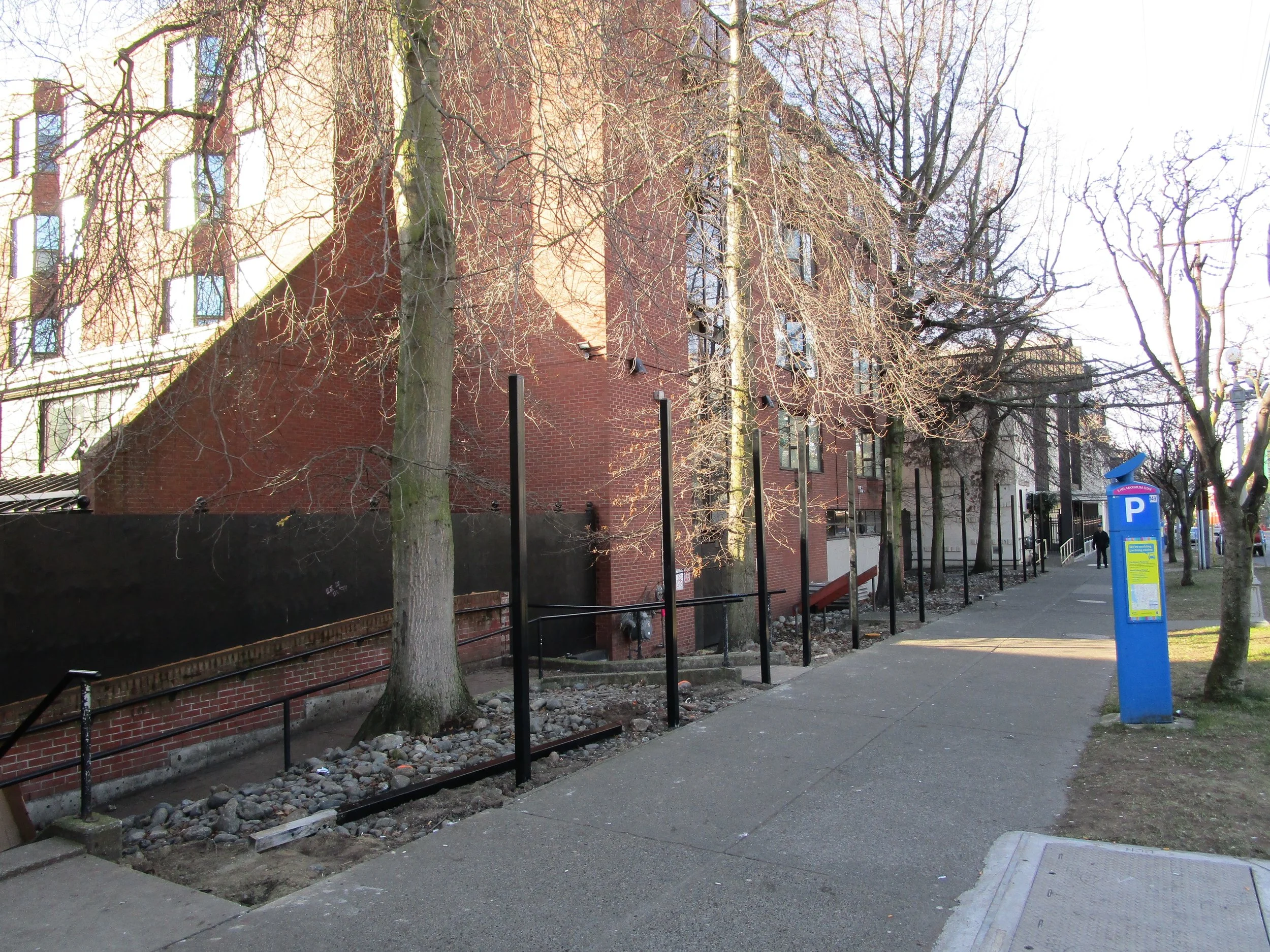Walls are in for 2017
Always one for keeping up with the latest trends, Portland Hotel Society is building a wall on the Pandora Avenue side of their Johnson Street Residence. And what a wall it will be! Only the tallest marginalized Victorians will be able to access the valuable stairwell, stones, and no trespassing signs inside.
Portland Hotel Society wall under construction, Pandora Avenue.
According to a CBC interview with Councillor Charlayne Thornton-Joe, when the building’s use changed last year it was reviewed under the city’s “Crime Prevention Through Environmental Design” policies (more below). A report sent to BC Housing suggested they add lighting, trim trees, and build a wall. Thornton-Joe says the wall means people will “have to find another location.”
The new wall has been in the works for months, but the hasty construction started over the weekend may be a response to videos that showed individuals using and dealing drugs in a stairwell adjacent to the building.* I’d like to briefly note the views of the person who shot those videos, which I haven’t seen reported elsewhere. Their goal was to get the provincial government “To build a wall around That area Like the Church Next door did.” The author says they created the videos “to publicly shame people,” and they describe individuals who use or sell drugs as “vermin.” Gross.
We’re going to build a wall, and poor people are going to be displaced for it
The consequences of Victoria’s new wall, according to a statement by the Victoria Police Department, will be “some displacement.” That almost sounds as though the police think defensive architecture is a bad thing, but in the same breath they link to pamphlets praising their “Crime Prevention Through Environmental Design” policies, which recommend building fences to provide “clear distinctions between private and public spaces.”
While Mayor Helps was quoted in the Times Colonist as saying she “personally [doesn’t] think fences are the answer,” and Councillor Thornton-Joe said she “would love to never have to approve a fence,” defensive architecture is entrenched in city policy. City advisory panels recommend using gates and designs that don’t “facilitate unintended use (places to sleep, etc.).” The city uses 2010 guidelines that advocate for fences and gates to prevent “nuisance trespassing.” For the best possible wall, the city’s consultants suggest designs that don’t “result in a fortress-like appearance,” and colours that “contribut[e] to pedestrian interest.” A friendly reminder to Portland Hotel Society, which currently looks like it’s preparing for a siege: rose quartz is so last year.
Screenshot from Victoria's "Guidelines for Fences, Gates and Shutters," 2010.
The police department and the city can’t have it both ways. If they don’t like walls and they don’t like displacement, then they should tear up their policies that explicitly support walls. Until they do, more walls will be built, more people will be displaced, and more walls will be built to displace the displaced.
“Crime” is code
The new Pandora wall ostensibly isn’t about homelessness at all, of course – it’s about Victorians’ number one policing concern, as reported by VicPD: “drug activity.” The other items on that list are very telling, however. The third-biggest policing concern for Victorians is “homelessness,” and Victorians’ sixth-biggest concern is “panhandling.” The respondents to the survey might be interested to learn that homelessness isn’t a crime, and panhandling is hard, low-paying work. Even VicPD acknowledges that most of Victorians’ top policing concerns aren’t criminal activities.
Of course it’s not only street-entrenched people who participate in Victoria’s drug economy. But without private space, these individuals are the most visible and the most likely to be targeted by the police.
While Victoria and the police would likely say their wall strategy isn’t about reducing places to sleep – it’s about stopping crimers from criming – the end result is the same. The city guidelines make it clear that walls are responding to “nuisance trespassing,” not drugs. And when you pair the new wall with its Central Baptist church counterpart, it looks a lot like we’re talking about policing poverty. Victorians’ alleged number one fear – “drug activity” – is being used as a smokescreen to advocate for more defensive architecture to move visibly poor and homeless Victorians out of sight.
As long as the City and the police support it, expect to see more walls and more displacement in Victoria in 2017.
*I reached out to the Portland Hotel Society for comment but did not receive a response before publishing this post.

